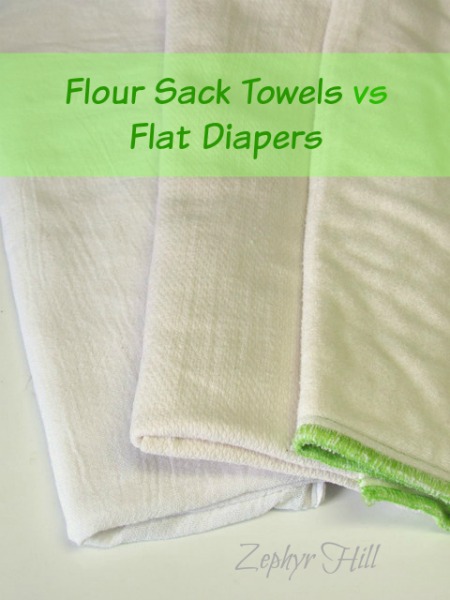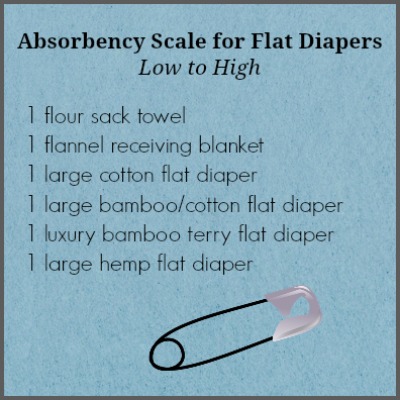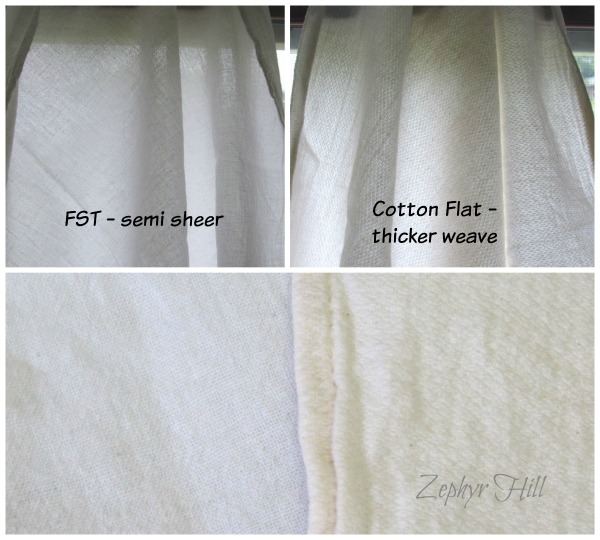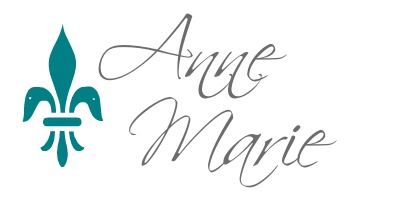
Since we’re using only flat diapers this week, I thought a post which compared the absorbency of “flour sack towels” (or FST, as they are often abbreviated) against other flat diapers would be helpful.
First of all, here’s a simple absorbency scale I made based on our experiences over the years of using many types of flat diapers. Do you agree with the rankings?

Flour sack towels aren’t really diapers, of course. But they are a simple and cheap way to get started with cloth because you can find they at nearly any big box store and they cost a dollar or less apiece. How absorbent are they, though? Compared to other flats, I would say that FST score pretty low, unless they are doubled up. Ingrid can barely go 1 hour before she saturates 1 flour sack towel. Two FTS’s together will work for maybe 4-5 hours max; overnight it’s too bulky/clumsy to use 3. Everyone I’ve talked to who actually uses FST’s overnight has to add some sort of double or insert to the towels.
I’ve found that 2 FST’s folded together equal the absorbency of ONE of our bamboo flats, so I prefer to just use the bamboo flat. Why not use one diaper instead of two? It’s trimmer, not that much more expensive, and one less diaper to launder.
I also like that when you buy actual flat diapers from a shop, you get service and a warranty to back up your purchase.
In terms of softness, bamboo flats have an edge over FST’s and plain cotton flats.
You might be wondering, if other flat diapers are softer and more absorbent, why would someone choose to use flour sack towels? I think there are many answers to this question. Some thrifty mothers take a lot of pride in being able to say they didn’t spend more than a dollar for their baby’s diapers. If using something they already have, or were given, then it means you’re diapering for nearly free (because of needing covers).
And some people just prefer the fabric with its thin, semi-sheer look and feel. You could argue that since it’s so lightweight, it’s even easier to clean and dry than regular flats.
There’s also a little bit of old-fashioned romance when it comes to flour sack towels. After all, they were the invention of creative housewives in the early 1900’s who discovered that empty cotton flour bags could be cut up and turned into household items like clothing, linens and yes, diapers.
However, keep in mind that modern “flour sack towels” aren’t much like the originals (this has been confirmed for me by several women who actually made and used real flour sacks). Real FTS’s were made of sturdy, tightly woven cotton because it had to keep the flour (or grain) inside fresh and protected from vermin. The flour sack towels you pick up at Wal-Mart and Target are much thinner, and semi-transparent. These photos compare a modern FST with 100% cotton birdseye fabric:

Here are how the prices of flat diapers stack up:
-
- Flour sack towels are $1 or less each
- Cotton flats are $2 each
- Bamboo/cotton flats are $3 and up each
- Luxury bamboo terry flats are $8 and up each
- Hemp flats are $9 and up each
I understand that for someone on an extremely limited budget, or who already has towels or receiving blankets in the house, purchasing “real” flats may not be the best option. Or, for reasons mentioned above, you may just love FST’s despite the drawbacks.
Flour sack towels can also work as doublers, since they are thinner than other flats when folded up, or for tiny newborns who don’t need a lot of absorbency. You can also stuff them inside pocket diapers, but again, I want to stress that they just aren’t as thirsty compared to other options.
For overnight use, I’ve had great results with 2 bamboo/cotton flats folded together. This holds Ingrid (who’s 22 months) all night long.
There are a lot of different flat diaper folds; I was able to keep it simple this week and pad fold Ingrid’s diapers because she’s very “regular” at 22 months.
What about diaper fasteners? Experiences may vary, but for us a Snappi or Boingo works best on cotton flats and bamboo flats. They will grip our FST’s, flannel blankets and hemp fabrics, but just not quite as well.
Do you use flour sack towels as diapers? How do you have to use two at a time or double them up for enough absorbency?


I was also thinking that investing in some flats instead of flour sack is a better route because you have to double up on fsts since they are not as absorbent and they are not as durable. I think people are better off investing in some durable flats from the start. Have you tried both of nicki’s and diaper rite’s bamboo flats? I have nicki’s and I am wondering if DR’s flats are worth the buy.
Diana, right now I think the Nicki’s flats are about $10 more, but I have both brands and they are VERY similar, so no major differences I can see. Nicki’s may be a bit higher to allow for the Buy One Give One diaper charity program she runs. ~Anne
I’ve never tried flour sack towels, but that’s interesting to know they’re not the same as they used to be. I was blessed to find my unbleached cotton flats for $1.25 each when I was pregnant, so I bought 36 of them. And it’s a good thing I did; our baby girl goes through diapers like crazy!
You got a great deal on the flats! Unbleached are my favorites for softness. ~Anne
I only use flour sack towels wrapped around a hemp insert in my pockets. They work great for me that way. I can’t see using them alone. They would never hold up for my heavy wetter. Plus I think they are too thin for snappis. I think the comb on the snappi would go right through and poke your baby.
Yes, I had that experience with the Snappi’s too. And I would agree that FST’s seem to work best with some type of doubler added, whereas other flats perform well alone. That’s what I hear from most mothers. ~Anne
Interesting article. We used flats several times, but they were homemade from flannel sheets or fst flats. I would do a kite fold with the fst and then pad fold a receiving blanket and use as an insert. then snappi the diaper on. I also found the fst not as absorbent as a flannel sheet. It worked well enough, but I was glad when I had sewed enough fitteds st which point the flats just became inserts for the fitted diapers. If I was going to have another baby I’d like to buy a couple bamboo flats just to try them out.
Amanda, I love the way you were able to diaper your baby with diapers you made or assembled yourself. I’m going to try that kite fold you suggest with one of my pad folded bamboo flats inside for over night. Thanks! ~Anne
FST are the bulk of my stash for this challenge. I also hemmed a piece of cotton flannel that I had left over from another project. I find that the snappis work better on the FST than on the flannel, but I haven’t really had too many issues with using then on either. I didn’t feel justified buying real flats for the challenge, as it only lasts a week and I already have a regular stash of diapers. But, surprisingly, I haven’t had an absorbency issue during the day with my 2 year old. At night, I use two, and a home made bamboo doubler, and we’very done pretty well there, as well.
I can definitely see why it would make sense to do FST-only for the challenge, since it’s temporary and you don’t want to make a huge investment. Plus, it makes it more of a challenge! And just like you said, FST’s only seem to work at night with something else added. I’ve never been able to use just 2 alone for more than 4-5 hours. ~Anne
I currently use FST for my newborn’s pocket diapers and covers. One FST works for him, but he also does not require a whole lot of absorbency. I did the flats challenge a few years ago with my other son and used FST but had to double them up like you said and included a hemp insert for nap or night time. I too found it a nuisance to use two FST and it cost just as much as my Indian cotton prefolds (which I love), but the only advantage that I see to FST is that they dry much quicker than most flats.
That’s a great point, Alanna – because they are thin they probably dry the quickest of any flat. And I love your idea of using them for a newborn, in that first week or two when they don’t need too much absorbency, but trimness is really nice. ~Anne
I’d love to see you compare the absorbency of a standard sized flat to a large flat someday, too! (They’re clearly MORE absorbant, but it’d be interesting to know HOW much more, and I just don’t have time!)
I use FST with my nine month old baby. One single towel can last up to three hours. For nightime I use prefolds with cotton doublers (I only use cotton). I plan to try cotton flats later on. I did the math many times, and FST were by far the most covenient route for us. My whole stash has 30 FST, 24 prefolds, and 36 cotton doublers and I spent less than 80 dollars. I love my system!
I wish I could get by with just one FST, Diana, but my baby soaks it in about an hour. I do like how economical they are, and versatile, too! And I’m glad more of the cloth diapering stores are offering different types of flats so you can find what works best and still get the benefit of budget-friendly, easy to clean, quick-dry fabric. Thanks for sharing your experience, and the amazing prize you paid for your system! ~Anne
I used fst with mf inserts for day and a stuffed Kushie pocket with mf inside fst at night so far so good. I am looking for a new fold though that is simple to put my inserts in, fits a bigger baby and focuses absorbency in the front.
I have tons of high quality quilting cottons in my fabric stash. Do you think they would work ok as “fst” flats if I serged the edges?? Yes, they cost moe per yard than fsts, but it is money I spent a long time ago and I have a lot in house. Would snappies work, or should I use pins?
Sandi, I asked this question of some sewers and the consensus was that cotton quilting fabric might not be as absorbent as other cottons (like flannel). Since you have all that fabric, however, it might be worth it to run a test y sewing a few layers together, wash and dry a few times, and then see how quickly it soaks up liquid that’s poured onto it. Also, I don’t think Snappi’s work well with woven cottons, so if your quilting fabric does end up being absorbent enough to your liking, pins would be ideal. ~Anne
Flour sack towels (FSTs) are a cheap way to start cloth diapering, but their absorbency is limited. Doubling or tripling them can get bulky, especially overnight, making bamboo flats a better choice. A single bamboo flat is trimmer, more absorbent, and only slightly pricier, saving time and effort in laundry. While FSTs work as backups, investing in higher-absorbency options like bamboo or hemp is more practical and convenient.